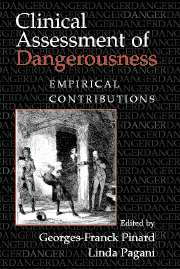Book contents
- Frontmatter
- Contents
- Contributors
- Prologue
- Introduction
- Basic Issues in Violence Research
- Mental Health Issues and Dangerousness
- Family Issues and Dangerousness
- 8 Risk Assessment for Intimate Partner Homicide
- 9 Parents at Risk of Filicide
- 10 Parricide
- Individual Characteristics and Dangerousness
- Conclusion
- Index
8 - Risk Assessment for Intimate Partner Homicide
Published online by Cambridge University Press: 03 July 2009
- Frontmatter
- Contents
- Contributors
- Prologue
- Introduction
- Basic Issues in Violence Research
- Mental Health Issues and Dangerousness
- Family Issues and Dangerousness
- 8 Risk Assessment for Intimate Partner Homicide
- 9 Parents at Risk of Filicide
- 10 Parricide
- Individual Characteristics and Dangerousness
- Conclusion
- Index
Summary
Intimate partner homicide represents a serious health and social problem throughout the world. The majority of research on the topic has been conducted in the United States, Canada, and Australia, with only limited cross-national investigations disaggregating intimate partner homicide from other forms of homicide (Gartner, 1990; LaFree, 1998). Even with the limitations in worldwide databases, it is clear that men are universally most often the perpetrators in intimate partner homicide as with homicide in general. When women kill a husband, boyfriend, or estranged partner, they are far more likely to be acting in self-defense than are men (Wolfgang, 1958; Easteal, 1993; Browne, Williams, & Dutton, 1998). In intimate partner homicide overall, estrangement, jealousy, and prior beating of the female partner represent major risk factors (Browne et al., 1998; Smith, Moracco, & Butts, 1998). Daly and Wilson (1998) conclude that the underlying dynamics of intimate partner homicide are basically “male sexual proprietariness and female attempts to escape male control” with the actual homicide only representing the extreme of the coercive control that characterizes battering. Most data from individual countries′ sources such as Africa, Australia, England, United States, and Canada support that general contention (Crawford & Gartner, 1992; Edwards, 1985; Mushanga, 1978; Easteal, 1993; Campbell, 1992).
Determination of risk of intimate partner homicide needs to be based on this underlying theoretical premise of male coercive control of females.
- Type
- Chapter
- Information
- Clinical Assessment of DangerousnessEmpirical Contributions, pp. 136 - 157Publisher: Cambridge University PressPrint publication year: 2000
- 31
- Cited by



